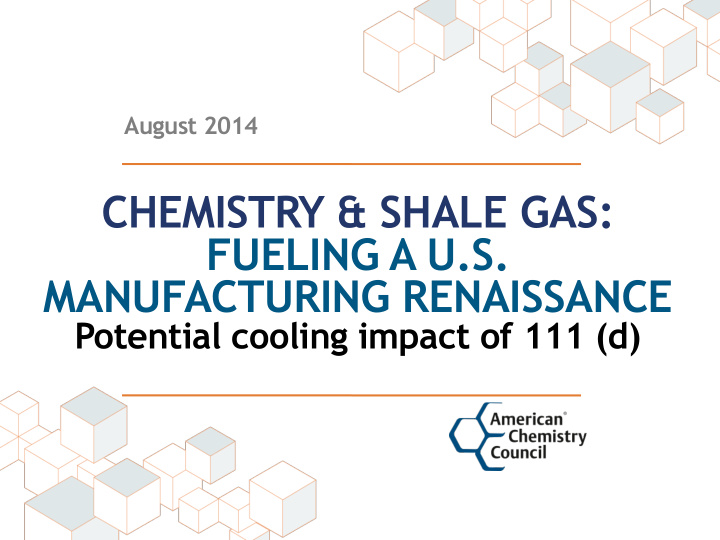



August 2014 CHEMISTRY & SHALE GAS: FUELING A U.S. MANUFACTURING RENAISSANCE Potential cooling impact of 111 (d)
What is Natural Gas? • Mixture of small hydrocarbon molecules that are all gasses at normal temperatures Methane is the most abundant constituent of natural gas, while • ethane, propane, and helium are also present Dry gas is almost all methane and is usually used for energy • • Ethane, propane and other molecules are removed from wet gas to make it dry Ethane is the primarily molecule for chemical production •
Shale Gas
U.S. Chemical Industry Global Cost Advantage Relative Position of U.S. (2005-2013) (Petrochemical Production Costs) HIGH RELATIVE POSITION 2012 PRODUCTION COSTS OF UNITED STATES OTHER IN 2005 NORTHEAST ASIA WESTERN EUROPE CHINA UNITED Estimated * ($/lb.) STATES IN 2013 MIDDLE EAST LOW GLOBAL SUPPLY (billion lbs.) *Based on estimates from best available data
U.S. Shale Gas Chemical Investment 166 projects and $107 Manufacturing billion in potential capital renaissance due to investment announced as of increased access to April 2014 natural gas from shale …Up from 97 projects and Downstream partners are $72 billion as of March 2013 more competitive than 62% is by firms based ever outside the U.S .
Global Chemical Production: Growing Competitive Advantage for the United States (N. America and Western Europe Production of Basic Chemicals /Plastics; 1990 base) Data provided with permission from IHS Global Insight
Chemical Industry is Energy Intensive Use both natural gas and electricity as a feedstock Crack the natural gas molecule to make stuff Use electrical electrolysis processes Use both natural gas and electricity as an energy source Many of our processes require heat to begin the reaction Motors and electronic controls require electricity Proposed 111 (d) changes potentially will cause price pressure on natural gas due to utility fuel switching Cool economic expansion Reduce competitiveness
Winter Arctic Vortex
Benefits of Proposed 111(d) Energy Efficiency Focus Lowest cost to increase energy supply Products of chemistry create energy efficient homes and buildings Better more updated Model Energy Building Codes and combined heat and power systems key to energy conservation IECC 2012 is 30 more efficient than IECC 2006
Energy Efficiency Reduces Demand
August 2014 CHEMISTRY & SHALE GAS: FUELING A U.S. MANUFACTURING RENAISSANCE Potential cooling impact of 111 (d) Rudy Underwood American Chemistry Council rudy_underwood@americanchemistry.com
Recommend
More recommend